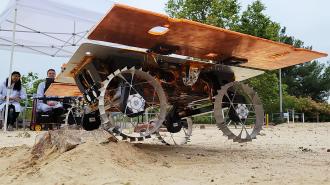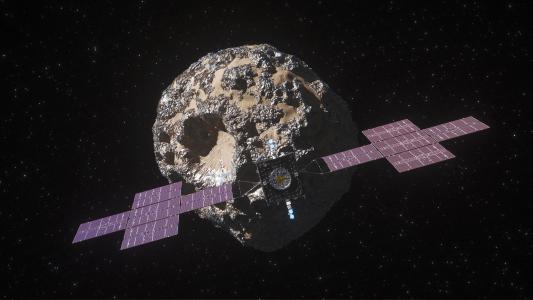NASA is sending three autonomous mobile robots to the moon where they’ll have to work as a team under challenging conditions.
“Our mission is to demonstrate that a network of mobile robots can cooperate to accomplish a task without human intervention – autonomously,” said Subha Comandur, manager of the CADRE (Cooperative Autonomous Distributed Robotic Exploration) project.
Autonomous mobile robots: Since the 1990s, NASA has sent five rovers to Mars, but it hasn’t sent one to the moon since the Apollo missions, and those Apollo devices had to be driven by astronauts — they couldn’t travel autonomously.
Now that NASA is gearing up to not only return people to the moon, but establish a long-term presence there, the time seems ripe to see just how helpful autonomous mobile robots could be on the moon’s surface.
“[CADRE] could change how we do exploration in the future.”
Subha Comandur
CADRE mission: Rather than sending just one rover to the moon, NASA is launching the CADRE project to see how much a team of lunar bots can accomplish.
Each rover is about the size of a carry-on suitcase. When the robots reach the moon’s surface in 2024, they’ll use their solar panels to charge up before spending about two weeks (one lunar day) conducting a series of experiments.
Each experiment will start with NASA sending general instructions to the rovers’ base station — this might be something as broad as “go explore this region,” according to Jean-Pierre de la Croix, CADRE’s principal investigator.
The moon rovers will then choose a leader amongst themselves, based on their current health status and individual fitness for the experiment. That robot will assign tasks to the others, each of which will need to figure out for itself the best way to meet its objective.

During one experiment, the autonomous mobile robots will drive in formation while using ground-penetrating radars and radio signals from one another to create a 3D map of the terrain up to 33 feet below their wheels.
“We’ll see how multiple robots working together – doing multiple measurements in different places at the same time – can record data that would be impossible for a single robot to achieve,” said Comandur. “It could be a game-changing way of doing science.”
Injured reserve: In addition to testing how well the autonomous mobile robots work together, NASA plans to use the CADRE project to assess how well they cope with losing a teammate.
It might not need to intentionally put one of the bots out of commission to do that, either — because the robots will be deployed near the moon’s equator, they could face temperatures as high as 237 °F.
To try to prevent overheating, NASA will power them down for 30 minutes after every half hour of work. Each time they wake up, they’ll share a health update with the team and choose a new leader before picking up where they left off.
Looking ahead: If the CADRE robots prove capable on the moon, NASA could start sending teams of the autonomous mobile robots to Mars or other places in the solar system.
“[CADRE] could change how we do exploration in the future,” said Comandur. “The question for future missions will become: ‘How many rovers do we send, and what will they do together?’”
We’d love to hear from you! If you have a comment about this article or if you have a tip for a future Freethink story, please email us at [email protected].






